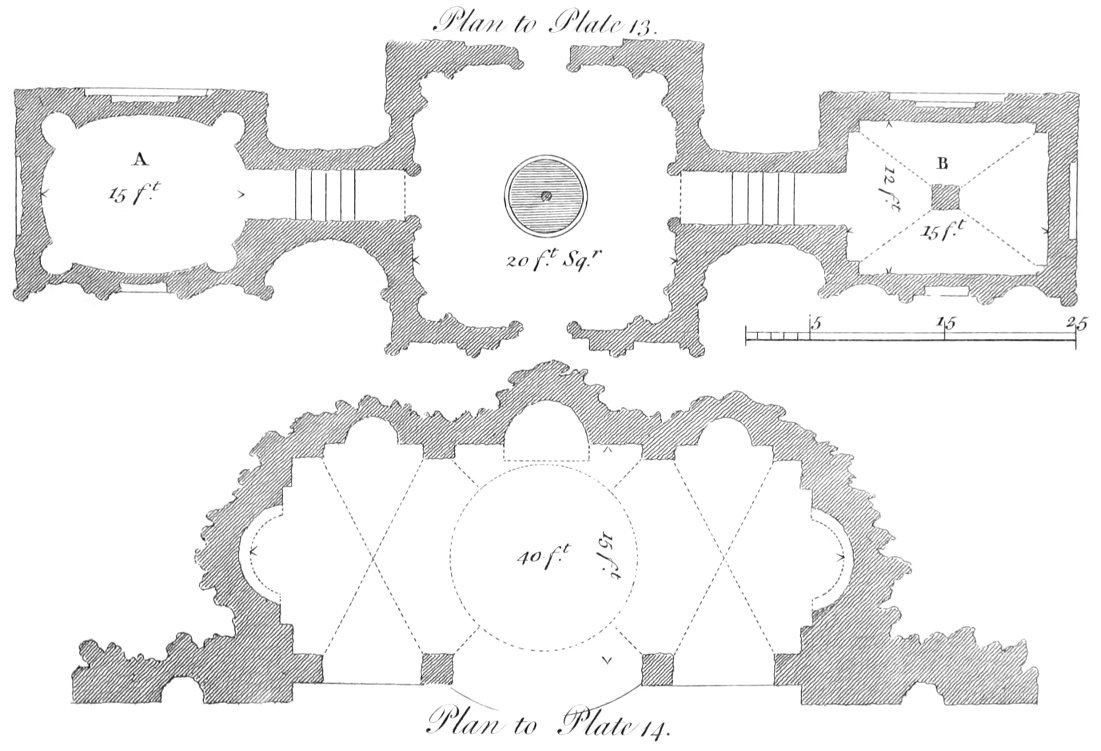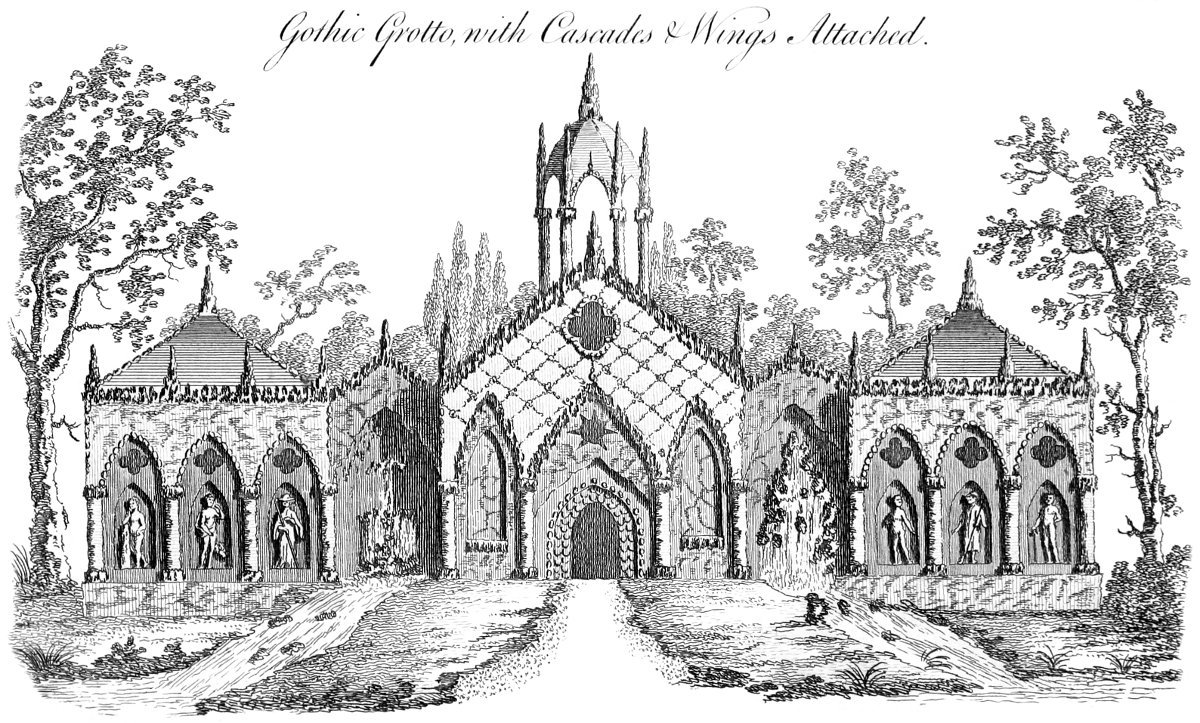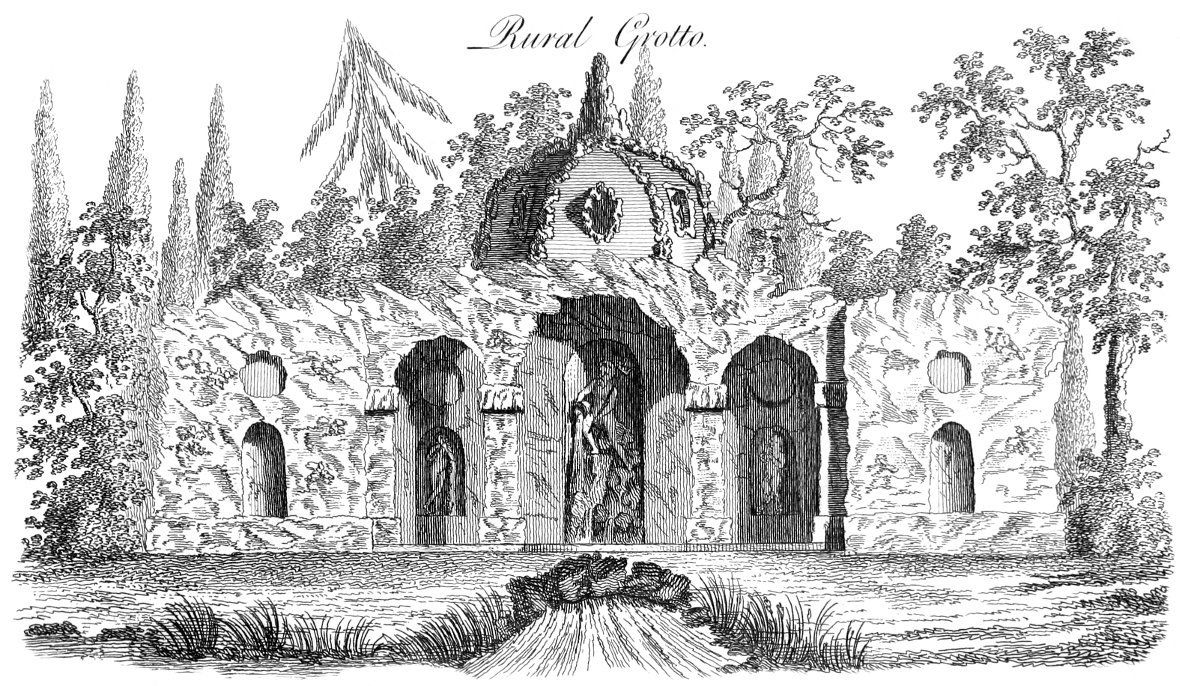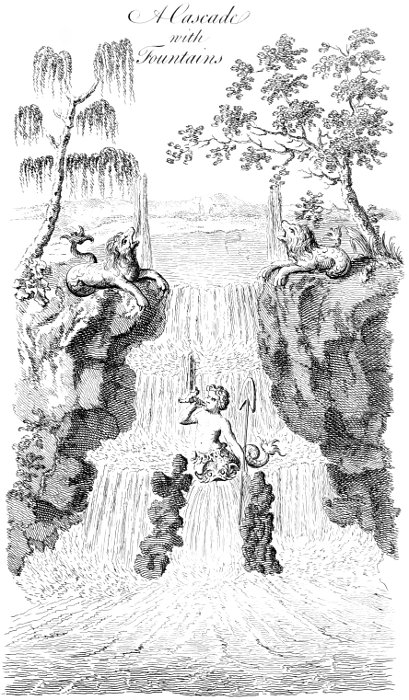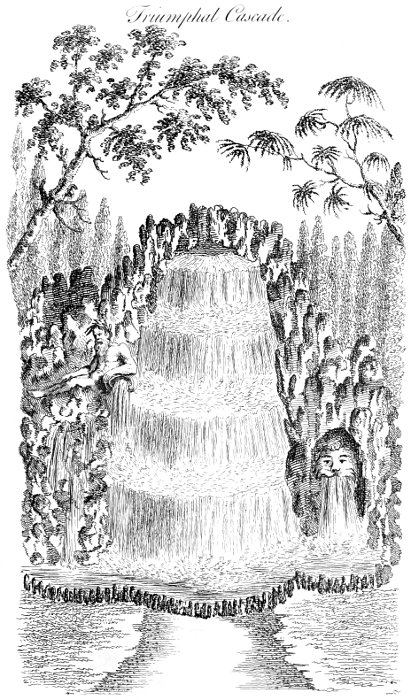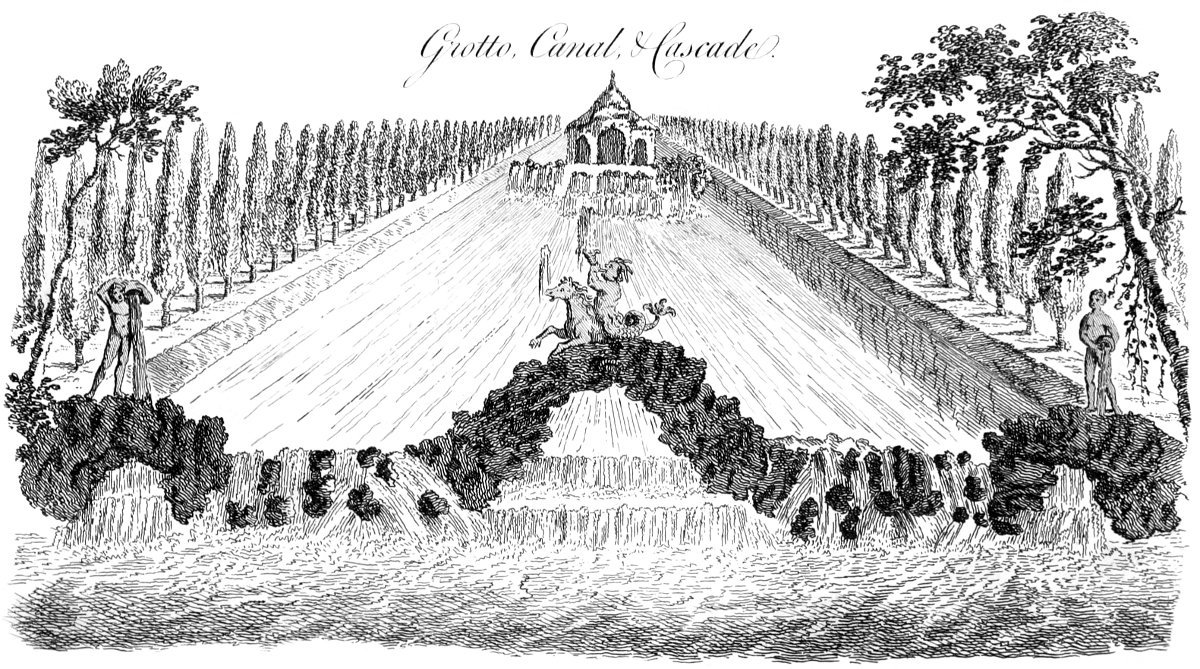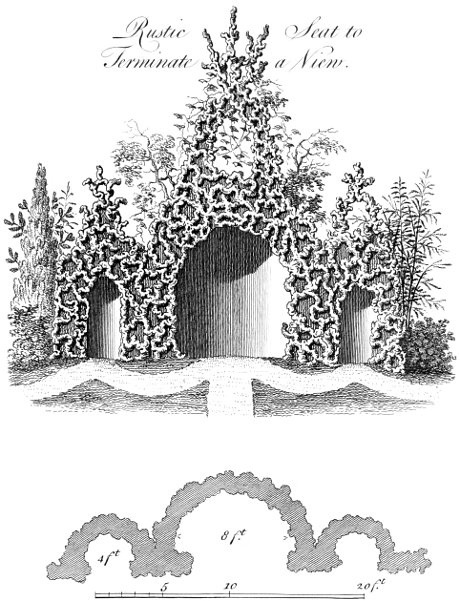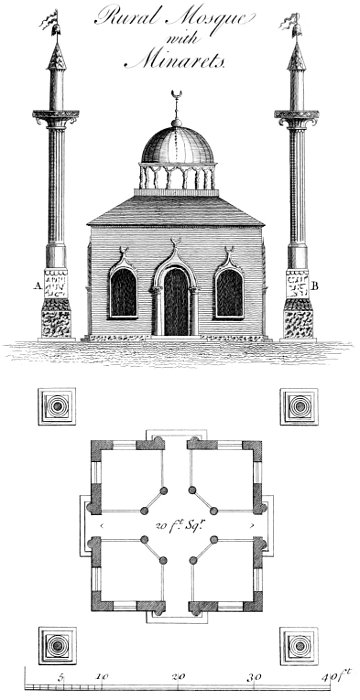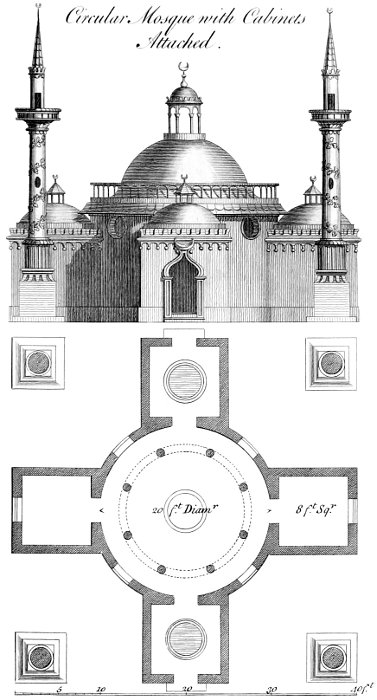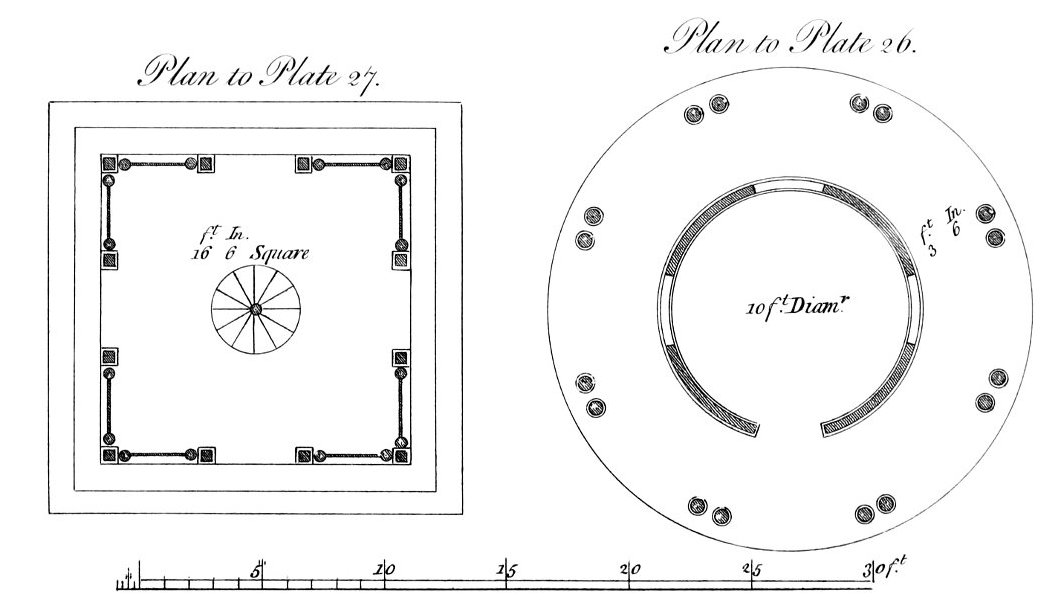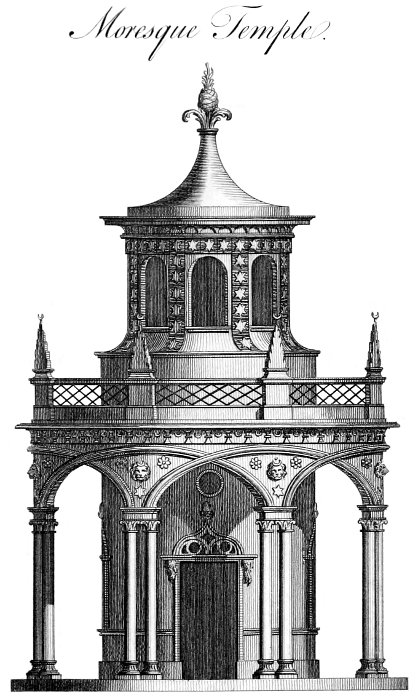PLATE I.
Plan and elevation of a hut, to be built with trunks of trees and irregular timber. The inside walls may be lined with moss, and covered on the top with thatch. It is intended to represent the primitive state of the Doric Order, and is proper to be placed at the entrance of a wood, or on the top of a small eminence. The dimensions are figured on the plan.
PLATE II.
Plan and elevation of an hermetic retreat, to be composed of roots and irregular branches of trees, cemented together with a strong binding clay, and may be thatched or covered with branches of trees twined round with ivy. The dimensions are figured on the plan.
PLATE III.
Elevation of an hermit’s cell, with rustic seats attached, eight feet square in the inside, which should be situated in a rising wood near some running water, to be built partly of large stones and trunks of trees, set round with ivy, and lined with rushes, &c. The roof should be covered with thatch, and the floor paved with small pebble stones or cockle shells. The seats attached are intended to be composed of large irregular stones, roots of trees, &c.
PLATE IV.
Plan and elevation for an hermitage, in the eastern style, supposed to be built round a tree which supports its roof; over the door is a tablet, with an Arabic inscription; the roof is covered with thatch, in the Chinese taste; the inside to be lined with billet wood and moss. It is lighted from the lanterns above. A. should be a couch; B. C. are seats of retirement. The dimensions are figured in the plan. The rustic seats on the side are intended to be composed of large rough stones and roots of pollard trees cemented together.
[p4]
PLATE V.
Plan and elevation of a winter hermitage, intended as a retirement from hunting, fowling, or any other winter amusement; the walls to be built of flints or rough stones, and lined with wood or other warm substance intermixed with moss, and should be situated on a rising ground planted with evergreens.
PLATE VI.
Plan and elevation of a summer hermitage, designed to be in a wilderness or thick wood; the walls to be composed of large stones, and the ends faced with flints; the roof covered with thatch, and an owl carved on the top; the floor should be paved with sheeps marrow-bones placed upright, or any other pretty devices intermixed with them. A. is for a couch; B. C. are seats of retirement.
PLATE VII.
Plan and elevation of an hermitage in the Augustine style; the front is ornamented with a portico of palm trees; in the pediment is a scull, and a tablet with an inscription. A. A. are passages of evergreens leading to the two circular retreats, one of which is intended as a library, and the other a bath; the tops of them are intended to be thatched; b b b. are niches for seats cut in the evergreens. This design is calculated to be built on a small verdant amphitheatre, near a murmuring stream, and as a proper retreat from the fatigues of a sultry day.
PLATE VIII.
A plan, half an elevation, and half a section, of a rural circular hermitage, designed for an open situation near some rivulet, planted with weeping willows, &c. The inside is lighted by a gazebo, supported by eight trunks of trees twined about with ivy. The dimensions are figured on the plan.
PLATE IX.
Plan, elevation, and section, of a grotto in a modern architectonic style, ornamented with jet d’eaux, sea weeds, looking-glass, fountains, and other grotesque decorations. The dimensions may be known by the scale and the figures on the plan.
PLATE X.
Plan and elevation of a Gothic grotto, with four closets five feet square; the outside to be composed of flints and irregular stones, and studded with small pebbles; the inside to be ornamented with shells, ores, &c. and if built upon an eminence, it would have a very pleasing appearance.
[p5]
PLATE XI.
Plan and elevation of an open Chinese grotto, to be placed at the head of a grand canal, with a bath (A), and a Chinese temple (B), attached; the arcades to be ice or frosted work; the outside of the bath and temple to be ornamented with beautiful shells in the Mosaic taste; the inside to be groined over, as on the plan, and ornamented with shell-work and other beautiful incrustations. The whole extent is 75 feet.
PLATE XII.
Plan and measures to plate xiii. and xiv.
PLATE XIII.
Elevation of a Gothic grotto, with cascades and wings attached (see the plan, plate xii.) The entrance is a saloon of 20 feet square; the angles are couped with off niches, where grotesque statues or vases should be placed. It is intended to have a fountain in the centre, with antique figures spouting out water; the walls should be lined with flints, decorated with ice-work; the whole is lighted from a gazebo on the top. A. B. are the plans of the two wings or repositories, which are each descended to by a flight of four steps. A. is intended to be ornamented with curious shells, gems, coral, &c. with statues in the niches. B. is to be groined over in the Gothic manner, with a pier in the centre to be lined with flints, intermixed with shells, looking-glass, &c. The groins should be incrusted with frosted work, in the manner of dropping icicles. Both these wings are lighted from the rose arches, as appears in the elevation; the outside to be composed of rough stones incrusted and studded with pebbles, shells, &c. There are placed in the recesses Gothic figures. The situation should be in some retired copse, shaded by an adjacent hill, near some murmuring rivulet, where the cascades, or rather fountains, as in the design, may be easily effected. The measures are marked on the plan.
PLATE XIV.
Elevation of a rural grotto (see the plan, plate xii.) which should be built of large rough stones rudely put together, so that the building may as near as possible imitate the beautiful appearance of nature. If the dome was to be richly ornamented with pendentive shell and frosted work, it would look very elegant. In the middle niche is Neptune on a rock, pouring out water, which descends under the pavement through an arch, and forms a running stream. The side niches are ornamented with satyrs and other grotesque figures. The situation should be in a morass, near some water.
[p6]
PLATE XV.
A design for a cascade or cataract of a great fall of water, decorated with rock-work, sea lions pouring out fountains of water; and a triton by way of embellishment, in the centre.
PLATE XVI.
A design for a triumphal cascade of four falls of water. If care is taken to erect this arch with rude and irregular flints, &c. at the same time paying a due observance to nature, it will have a very magnificent appearance, and look extremely elegant; and would be a superb ornament in a nobleman’s park where there is a great supply of water.
PLATE XVII.
A grotto, canal, and cascade, decorated with rock-work, tritons, sybils, &c. pouring forth fountains of water. The author hopes he may be indulged with observing, that he hath with great pleasure seen a fine piece of water in the park of the Earl of Essex, at Cashiobury, near Watford, Herts, and flatters himself, that if the arch in this design, on which the triton is placed, was to be executed there in the nature of a bridge, it would have a very magnificent and pleasing appearance.
PLATE XVIII.
A romantic bridge, or a cascade of three sheets of water, descending through arches of artificial rock-work, incrusted with shells, corals, sea-weed, moss, &c. and two sea gods lying on their oozy couch, pouring out water.
PLATE XIX.
Plan and elevation of a rustic seat for a garden or park, intended to terminate a view. It would look very pretty if it was built with flints, or irregular rude branches and roots of trees.
PLATE XX.
Plan and elevation for a grotesque or rural bath, very proper to be built in gardens, &c. for the benefit of bathing. It is intended to have three seats within, by way of closets, for the convenience of dressing and undressing. If the water in the plan be left out, it will look very pleasing as a rural hut.
PLATE XXI.
Plan and elevation of a rural mosque with minarets. It is divided into an octagon saloon, supported by eight columns, lighted from the dome. The other apartments are four regular small rooms or closets, which will serve for various [p7] purposes. The minarets are placed in the plan by way of ornament, to shew the true taste of the Turkish buildings; and the singularity of the style of architecture is such, that will render it a very pleasing ornament, if executed in a pleasure ground, or upon an elevated verdant amphitheatre. It may be built of wood, and stuccoed; the inside should be painted with various rich colours, which would have a pleasing and elegant appearance. The dome is supported by irregular branches of trees, well connected and cramped together. The minarets should be solid, and the pedestals (A. B.) should be decorated with Arabic inscriptions. For a more intelligible and historical account of these buildings, I must refer the reader to Dr. Shaw’s Account of Barbary, Le Brun and Tournefort’s Voyage to the Levant, &c.
PLATE XXII.
Plan and elevation of a circular mosque twenty feet diameter, with four cabinets attached, eight feet square; two of which may serve for entrances, having each a small fountain, five feet diameter; the other two may be for the purposes of study or use. The four minarets at the angles bring the plan upon the square of forty feet. The cabinets, as well as the mosque, are crowned with domes, which should be gilt on the outside. The great dome is supported by eight columns, over which are groined arches; an iron balustrade runs round the outside, which may be painted blue, and gilt; on the top of the great dome is a light cupola, supported by eight small columns, from whence hangs a chandelier to light the inside when required. The other decorations may be seen in the section, plate xxiv.
PLATE XXIII.
Plan and elevation for another mosque, with two minarets attached to the body of the building, which may be executed in brick of 14 inches thickness. The front is a portico of four columns, in the oriental style, in the centre of which is a fountain for sabateons; which may be seen in the section, plate xxiv. The niches in the front should have Arabic inscriptions in gold letters. The portico is covered with three little domes, in the Turkish manner, ornamented with crescents, &c. The inside is lighted from the circular windows and little arches above, which support the dome. For the interior decoration, see the section, plate xxiv. It would look very beautiful if built on an open lawn, planted round with a few cypress or other exotic trees. The dimensions are figured on the plan.
[p8]
PLATE XXIV.
Sections and scales to plates xxii. and xxiii.
PLATE XXV.
Two plans of moresque temples to plates xxvi. and xxvii. with their proper measures.
PLATE XXVI.
Elevation of a beautiful moresque temple (see the plan, plate xxv.) The coupled columns support an arcade of intersecting semi-ellipses, which goes quite round the temple. In the spandrells are Moors heads, with crescents, roses, and stars, over which is a parapet balustrade of net or lattice-work. The body of the temple is 20 feet diameter, crowned with an open lantern, from whence it is lighted; the outside of which is adorned with stars of glass of an azure ground. On the top is a pine, which should be double gilt; and if the outside was covered with a glossy substance, it would have a very pleasing and magnificent appearance. The style of architecture is a medium between the Chinese and Gothic, having neither the levity of the former nor the gravity of the latter. The particularities of both this and the following design are taken from those famous remains of barbarian antiquity, the palace of Alhambra, at Granada, the ancient moresque mosque at Cordova, the old cassavee or palace of the Moorish kings at Mæquanez; for the accounts of which the reader is referred to Willughbuy’s Travels into Spain, Ockley’s Account of South or West Barbary, and Shaw’s Travels to the Levant.
PLATE XXVII.
Elevation of a moresque pavilion (see the plan, plate xxv.) in the style of the ancient Moors, raised on three steps. Over the arches are Moors heads and festoons. In the middle is a circular or geometrical staircase, leading to the top, or balustrade. It is crowned with a square cupola, mounted with a moresque standard; and is very proper to be built on an eminence to command an extensive view.
PLATE XXVIII.
Plan and elevation for a green-house of the grotesque kind, faced with flints and irregular stones. The dimensions may be found by the scale.












